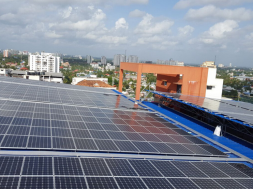
In this news, we discuss the Novel transparent solar cells boost efficiency beyond limits.
The climate change crisis demands a shift from conventional fossil fuels to efficient sources of green energy. Solar power has shown immense potential as a futuristic and “clean” energy source.
Technologists are looking for ways to advance current solar cell technology. Now, scientists have come up with an innovative design for the development of a high power transparent solar cell. This innovation brings us closer to achieving our goal of a sustainable green future with off-grid living.
Researchers are studying the concept of “personalized energy”, which is the production of energy. For example, solar cells could potentially be integrated into windows, vehicles, cell phone screens and other everyday products. But for this, it is important that solar panels are practical and transparent. To this end, scientists have recently developed “transparent photovoltaic” (TPV) devices, transparent versions of the traditional solar cell.
Unlike conventional opaque and dark solar cells (which absorb visible light), POS devices use “invisible” light which is in the ultraviolet (UV) range.
Conventional solar cells can be either “wet type” (solution-based) or “dry type” (made up of metal oxide semiconductors). Among these, dry-type solar cells have a slight advantage over wet-type cells: they are more reliable, environmentally friendly and cost effective. In addition, metal oxides are well suited for using UV light. Despite all this, however, the potential of metal oxide TPVs has not been fully explored so far.
To this end, researchers at Incheon National University, Republic of Korea, proposed an innovative design of a metal oxide-based TPV device. They inserted an ultra-thin layer of silicon (Si) between two transparent metal oxide semiconductors with the aim of developing an efficient TPV device.
These results were published in a study in Nano Energy, which was posted online ahead of the planned final publication in the December 2020 issue). Professor Joondong Kim, who led the study, explains, “Our goal was to design a transparent high-power solar cell, incorporating an ultra-thin amorphous Si film between zinc oxide and nickel oxide. . “
This new conception consisting of the film Si had three major advantages. First, it allowed the use of longer wavelength light (as opposed to bare TPVs). Second, it resulted in efficient collection of photons. Third, it allowed faster transport of charged particles to the electrodes. Additionally, the design has the potential to generate electricity even in low light situations (eg, cloudy or rainy days). Scientists further confirmed the device’s power generation capability by using it to run a fan’s DC motor.
Based on these results, the research team is optimistic that the real applicability of this new TPV design will soon be possible.
As for potential applications, there are many, as Prof. Kim explains, “We hope to extend the use of our TPV design to all kinds of materials, from glass buildings to mobile devices like electric cars. , smartphones and sensors. Not only that, the team is excited to take their design to the next level, using innovative materials such as 2D semiconductors, metal oxide nanocrystals, and sulfurized semiconductors.
“Our research is essential for a sustainable green future, especially for connecting the clean energy system with zero or minimum carbon footprint,” concludes Professor Kim.
















